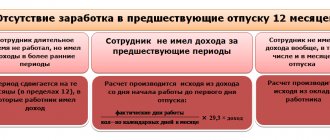Leave from part-time work and main place of work
There are two types of part-time workers: internal and external. Internal workers work for one employer under two different employment contracts. Accordingly, external ones work for different employers. Just like main employees, part-time workers have the right to annual paid leave.
Rest at both places of work must be provided simultaneously. In this case, at the main place, vacations begin in accordance with the approved schedule, and at the second job - based on the employee’s application. The employer from the second place of work does not have the right to refuse to provide such vacation, nor to demand from the subordinate any documentary evidence that the vacation dates coincide. The employer can only ask the employee to provide a certificate from the first place of employment, but nothing more.
As for internal part-time workers, the employer simply provides them with holidays for two positions at the same time. If an employee works in his second place of employment for less than six months, then the rest is provided to him in advance.
Results
Perhaps every enterprise has employees who strive to improve their well-being by working part-time, thereby increasing their working hours. Relations with this category of employees are regulated by Ch. 44 Labor Code of the Russian Federation. Registration of leave for part-time workers does not present any particular difficulties, however, it is necessary to take into account the features set out in the Labor Code.
Calculate your holiday pay using our online calculator.
Sources:
- Labor Code of the Russian Federation
- Code of Administrative Offenses
You can find more complete information on the topic in ConsultantPlus. Free trial access to the system for 2 days.
Part-timer's vacation pay
The amount of vacation pay is determined according to the general rules for calculating these payments, based on the average salary.
As for the order for the leave of an internal part-time worker, it indicates the dates of both periods. Form T-6a is usually used to prepare this document. It is used when it is necessary to issue an order for several people. In this case, it will contain two lines filled in for one specialist. However, the table will differ by personnel number, position and, possibly, structural unit. FULL NAME. and the dates will coincide. A sample of this document is presented below.
How is payment calculated?
For persons engaged in part-time work, payment of vacation pay
periods is carried out according to general rules. Funds are paid from the budget of the organization or enterprise. The exception is periods taken at your own expense, that is, without payment.
If the vacation period at an additional workplace is significantly shorter than the main vacation, the employee may qualify for payment of monetary compensation for unused days.
Such compensation will only be provided with the consent of the employer. Otherwise, the employee will receive additional days of rest without pay, so that the total number of days issued corresponds to the length of the vacation period at the main workplace.
Vacation without pay
This type of leave can be issued either on certain grounds or without them, that is, simply at the request of the employee (if the employer agrees). The reasons may be: the birth of a child in the family, the death of a close relative, marriage, studying at a state university or entrance exams. In addition, such leave is provided to disabled people (up to 60 calendar days per year), pensioners (up to 14 days), members of election commissions, family members of military personnel or employees of internal affairs bodies and other categories of workers.
In the above cases, as well as in some others, the employer cannot refuse the employee leave without pay. But only on the condition that he submits the relevant document. For example, when requesting student leave, a certificate of summons from an educational institution is required, when requesting leave by a disabled employee, a certificate of disability, and so on. In some cases, such documents may be provided after the vacation. This applies in particular to birth, death or marriage certificates. After all, the employee will receive these documents later than the period for which he requires a break from work.
If there is no documentary evidence of the need for leave, the employer has the right to refuse it. The issue of providing vacation without payment in the absence of legally established grounds is resolved by agreement of the parties.
To receive leave at his own expense, the employee must write an application. Based on it, as well as on the basis of the submitted documents, an order for leave without pay is issued. The line “for the period of work” is not filled in, since the vacation is not related to the time worked. Instead of block “A”, block “B” is filled in. Here you need to reflect the type of leave (without pay), indicate the number of calendar days, start and end dates. If its necessity is confirmed by a document, its details should also be entered in line “B”. Information about the duration and period of vacation must be duplicated in block “B”.
Responsibility
The absence of a vacation schedule in small companies and individual entrepreneurs is a common practice, although this is not true. Very often management does not think about or simply does not know about the need to draw up this document. At the same time, the requirement for its formation follows from Article 123 of the Labor Code of the Russian Federation. Its absence threatens the employer with a fine under Article 5.27 of the Administrative Code , since inspectors may regard this as a violation of labor law.
For the first time, a company under this article may be fined in the amount of 30-50 thousand rubles . If the violation is detected again, the fine will be 50-70 thousand rubles.
The entrepreneur-employer, as well as the official who committed the violation, will be fined the following amounts:
- for a primary violation - by 1-5 thousand rubles ;
- if repeated - by 10-20 thousand rubles .
Unified form T-7: is it necessary to use it?
For the vacation schedule, a unified form T-7 , approved by Decree of the State Statistics Committee of January 5, 2004 No. 1. However, employers are not required to use it unchanged. Based on the resolution of the State Committee of the Russian Federation on Statistics dated March 24, 1999 No. 20, the form can be modified. You can also develop your own template, approve it and use it as a vacation schedule.
In practice, employers most often use a unified form, although the table is often supplemented with the necessary columns.
Form T-7
The following image shows what the unified vacation schedule form (T-7) looks like:
Is there an additional payment for combining positions during vacation?
Combination is the assignment of additional responsibilities to an employee with the current employer (Article 60.2 of the Labor Code of the Russian Federation). In this case, a new employment contract is not concluded with the employee, but an additional agreement to the current contract is drawn up, which specifies all the conditions of the combination.
If it is time for an employee to rest, no additional statements are required from him. The combination of positions itself can only affect the amount of payments, since the additional payment is necessarily included in the calculation of average earnings
Calculation of vacation pay when working part-time
The Labor Code guarantees an annual 28-day vacation to an employee, regardless of his work schedule. However, the amount of time worked ultimately affects the calculation of vacation pay.
Vacation pay is calculated based on the employee's average earnings. And when working part-time, the salary is naturally less than that of someone who works full time.
Keep records of exports and imports in the Kontur.Accounting web service. Simple accounting, payroll and reporting in one service
How to calculate vacation pay for a part-time worker:
- The period for calculating vacation pay is determined. Either this is a fully worked year, or at least 6 months worked, after which you can already take a vacation.
- The number of days actually worked in each month is calculated.
- Based on the number of days, the average daily earnings are calculated. If an employee has worked the entire year in full, then the average earnings can be calculated using the formula: the sum of all payments minus vacation pay, financial assistance, benefits, and travel allowances already received is divided by 12 and then divided by 29.3 (the average number of days in a month).
- The resulting figure of average earnings is multiplied by the number of vacation days.
After writing the application
After the leave application has been written, it should be submitted either to the secretary of the organization or to a human resources specialist. Next, the responsible person must submit this document to the manager for review. After making a decision, the boss puts his resolution on the application, signs it and returns it.
The director may agree to provide leave within the requested period, offer leave at another time, or refuse. The refusal may be motivated by the fact that at the moment there is no one to replace the applicant (usually the vacation schedule is drawn up in advance and management always knows for sure who will replace this or that vacationer, which is excluded during extraordinary vacations). However, in some cases the refusal of leave is unlawful. In particular, regardless of the circumstances, you will have to let go of:
- working pensioner;
- disabled person;
- external part-time worker;
- student of a university, vocational school or other educational institution;
- other categories of employees prescribed in the Labor Code of the Russian Federation.
It should be noted that in most such cases, the employee is still required to provide the manager with documents confirming his right to unscheduled leave.
If, despite the documents presented, management refuses to allow an employee to go on vacation, they may be punished by a fine, so the law protecting the rights of employees must be observed.
Remuneration for a part-time employee.
By virtue of Art. 132 of the Labor Code of the Russian Federation, the salary of each employee depends on his qualifications, the complexity of the work he performs, the quantity and quality of labor expended, and is not limited to the maximum amount. Similar instructions are contained in the Unified Recommendations for the establishment at the federal, regional and local levels of remuneration systems for employees of state and municipal institutions for 2015, approved by the Decision of the Russian Tripartite Commission for the Regulation of Social and Labor Relations dated December 24, 2014, Protocol No. 11.
According to the general rule established by Art. 284 of the Labor Code of the Russian Federation, the working time of a part-time worker cannot be more than four hours a day. Thus, when accepting a part-time worker for a vacant position with a certain salary, the institution pays
as a worker, he receives half the standard working time, respectively, half the salary in accordance with Art. 285 Labor Code of the Russian Federation. Consequently, additional payments provided for in a fixed amount to the full official salary must be paid in proportion, that is, in the amount of 50% of the established amount. Paying more would discriminate against the work of other employees working in the institution in similar positions and receiving the same additional payment for the complexity and intensity of the work.
At the same time, the norms of Art. 285 of the Labor Code of the Russian Federation indicate payment of labor not only in proportion to the time worked, but also in accordance with the terms of the employment contract. And this, in turn, determines the independence of the parties to the employment contract in establishing the amount of additional payments. In other words, in the employment contract, the institution has the right to indicate a larger amount of additional payments, provided that it has the financial capacity to comply with these obligations. In practice, this is possible, as a rule, only at the expense of funds received by the institution from income-generating activities.
In particular, the remuneration of part-time teachers will depend on the teaching load assigned to them, which, in turn, depends on the number of hours according to the federal state educational standard, curriculum and programs, staffing levels and other specific conditions in a given educational institution. The distribution of the teaching load is carried out by the head of the educational institution. The volume of teaching load determined for a specific teacher is fixed in the employment contract.
In general, the salary of a part-time teacher will be calculated based on the cost of one teaching hour for a given employee, multiplied by the number of hours spent. And the cost of one teaching hour depends on the level of education, the availability of a qualification category, the length of teaching experience and the compensation and incentive payments established for this employee.
A similar approach is used when paying part-time doctors. When calculating their salary, a medical institution must take into account the qualification category, the presence of titles and academic degrees, compensation and incentive payments.
Let's consider an example of calculating wages for a part-time employee.
Example 1.
External part-time worker L.A. Ivanova, working as a nurse with an official salary of 5,100 rubles, worked in a dental clinic, which is an autonomous institution, in August 2015 for 75.6 hours (with a 36-hour work week). The employment contract stipulates that the employee’s remuneration is made in proportion to the time worked (Article 285 of the Labor Code of the Russian Federation). Additionally, the employee is provided with a bonus payment of 50% of the official salary. Payments are made from funds received from the provision of paid services.
Payment for hours actually worked by L. A. Ivanova in August 2015 will be 2,550 rubles. (RUB 5,100 / 151.2 hours x 75.6 hours).
The amount of the premium paid will be equal to 1,275 rubles. (RUB 2,550 x 50%).
The total amount of payments is 3,825 rubles. (2,550 + 1,275).
In the accounting records of the institution, in accordance with Instruction No. 183n[1], the following entries were made:
| Contents of operation | Debit | Credit | Amount, rub. |
| Employee's wages accrued | 2 109 60 211 | 2 302 11 000 | 3 825 |
| Insurance contributions to the Social Insurance Fund have been calculated in case of temporary disability and in connection with maternity (RUB 3,825 x 2.9%) | 2 109 60 213 | 2 303 02 000 | 110,92 |
| Insurance premiums for compulsory social insurance against industrial accidents and occupational diseases have been calculated (RUB 3,825 x 0.2%) | 2 109 60 213 | 2 303 06 000 | 7,65 |
| Insurance premiums for compulsory health insurance in the Federal Compulsory Medical Insurance Fund have been calculated (RUB 3,825 x 5.1%) | 2 109 60 213 | 2 303 07 000 | 195,08 |
| Insurance premiums for compulsory pension insurance have been calculated (RUB 3,825 x 22%) | 2 109 60 213 | 2 303 10 000 | 841,50 |
| Personal income tax withheld from the amount of accrued wages (RUB 3,825 x 13%)* | 2 302 11 000 | 2 303 01 000 | 497 |
| Employee's wages were issued from the cash register (3,825 - 497) rub. | 2 302 11 000 | 2 201 34 000 | 3 328 |
Vacation schedule: step-by-step instructions
Next, we will consider the step-by-step process of creating a vacation schedule in the T-7 form.
Step 1. Filling out form T-7
The form consists of a header and a table containing basic information. See below for how to fill it out. The active field is highlighted in color.
The header should include the following information:
- Organization name or full name entrepreneur. The name of the company must be indicated in full as it is written in the constituent documents. If the name in the charter is written in capital letters, it must also be written in the schedule.
- OKPO. Eight-digit code in accordance with the All-Russian Classifier of Enterprises and Organizations. You can take it from the information letter of the territorial division of Rosstat.
- Document number, date of its preparation and period of validity of the schedule - in our case this is 2021.
The preamble of the form contains fields for indicating the details of the document in which the union expressed its opinion regarding the vacation schedule, as well as for its approval. We will show you how to fill them out later, when the process reaches document approval.
The table of the unified form T-7 has 10 columns:
- Column 1. Name of structural unit (department):
- Column 2. Job title (specialty) according to the staffing table:
- Column 3. Last name, first name and patronymic employee:
- Column 4. Employee personnel number (indicated in the personal card or in the employment order):
- Column 5. Number of calendar days of vacation, which are due to the employee for the time worked. It also includes vacation days for the current year that the employee did not use:
- Column 6. Planned vacation date:
The remaining columns of the table are not filled in at this stage. They are intended to reflect information that will appear later - when the employee goes on vacation or if it is rescheduled.
Step 2. Approval
Labor legislation requires that the vacation schedule be coordinated only with the trade union ; it is not coordinated directly with employees. If there is a trade union, then the schedule is agreed upon with it in the manner established in Article 372 of the Labor Code of the Russian Federation.
Note! An employee can submit an application in which he asks that his wishes regarding the vacation period be taken into account. However, the employer is not obliged to approve it.
The vacation schedule can be approved even if the trade union is against it. However, the latter retains the right to appeal the decision of management to the Labor Inspectorate or in court .
Details of the document in which the union expressed its opinion regarding the schedule are indicated before the tabular part of the T-7 form:
Step 3. Signing by the responsible employee
So, the schedule has been drawn up and agreed with the union. Now you need to complete its design and sign it. The signature is placed by the head of the personnel service or another specialist responsible for personnel records:
Step 4. Manager approval
After signing, the schedule is sent to the employer’s manager for approval. two possible options here :
- endorsement directly in the header of the document;
- creating an order for approval.
In the first case, everything is simple: the preamble of the schedule indicates the position of the head of the company, and he puts his signature (with a transcript), as well as the date of approval:
In the second case, an order is generated to approve the vacation schedule . This path is sometimes chosen if it is necessary to give additional instructions to responsible persons related to vacations in general and the schedule in particular. For example:
- HR specialist - familiarize employees with the schedule;
- the accountant - to calculate vacation pay and create a cash reserve for their timely payment.
The order is drawn up in any form - an example can be seen below. When choosing this option, the schedule itself will be an attachment to the order.
An order approving leave is an optional document. Form T-7, approved in the manner indicated above, is a self-sufficient document.
Step 5. Employee familiarization
The law requires that employees be provided with information about the upcoming vacation no later than 2 weeks before it starts . But it is advisable to do this also immediately after drawing up the schedule.
The standard T-7 form does not provide special columns for employees to familiarize themselves with, but employers can add them. The change in form must be approved by order or direction of management.
It is advisable to add two columns - for the date of review and the employee’s signature.
There are other ways to familiarize employees with the vacation schedule, for example, you can make a special sheet for this in the document.
The finished schedule, approved in the prescribed manner, and also containing notes on familiarization, looks like this:






